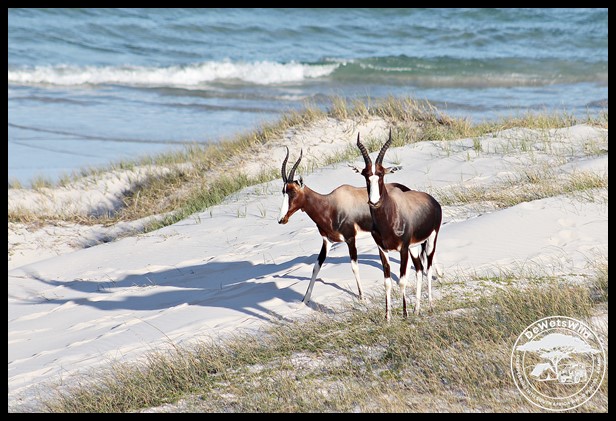Damaliscus pygargus pygargus
The Bontebok is a medium-sized antelope endemic to a small piece of South Africa’s southern coast and adjacent interior, stretching from Caledon in the west to Mossel Bay in the east, and from the Langeberg Mountains southwards to the ocean both east and west of Cape Agulhas. Considered abundant in early colonial times, hunting, competition for grazing with domestic stock and loss of habitat almost drove it to extinction. The IUCN considers the Bontebok’s conservation status as “Vulnerable” due to its restricted distribution, fragmented and transformed habitat, low numbers and the threat of hybridisation with the closely related (at subspecies level) Blesbok. The effort to save the Bontebok from extinction became a national priority in the 1930’s with the proclamation of the Bontebok National Park (read here for more). While there may now be as many as 3,500 Bontebok in the country, many of these are on private properties both within and outside their historical range and may possibly be hibridised, with only approximately 700 or so individuals tested for genetic purity and occurring at four formally protected areas (of which Bontebok National Park is one) within the historic distribution of the species. The Cape of Good Hope section of the Table Mountain National Park is another good place to see Bontebok, but that population is considered to be outside their natural distribution range.
Bontebok are almost exclusively grazers, showing a preference for areas of short grass and recently burnt veld, usually in open, undulating areas with good visibility in the heathland (fynbos and renosterveld) that cover their limited distribution range. They are dependent on easily accessible water sources and stay within 1.5km from a reliable supply, especially in the dry season. Thickets are important as refuges from cold weather. Bontebok stand around a meter high at the shoulder and weigh around 60kg.
From about the age of 5 years, adult Bontebok rams establish small territories (4 to 30 hectares) which they mark with dung heaps and defend throughout the year, and in which they attempt to keep breeding herds consisting of ewes and lambs for as long as possible so as to mate with any receptive females. The females in the breeding herds, which number between 6 and 30 animals, maintain a strict hierarchy. Young rams, and older males displaced from their territories, roam together in bachelor herds which are often even bigger than the breeding herds. The rutting season peaks from January to March, with most lambs being born in September and October. Ewes give birth to single lambs weighing around 6kg that can run with the herd within an hour of birth!

















































